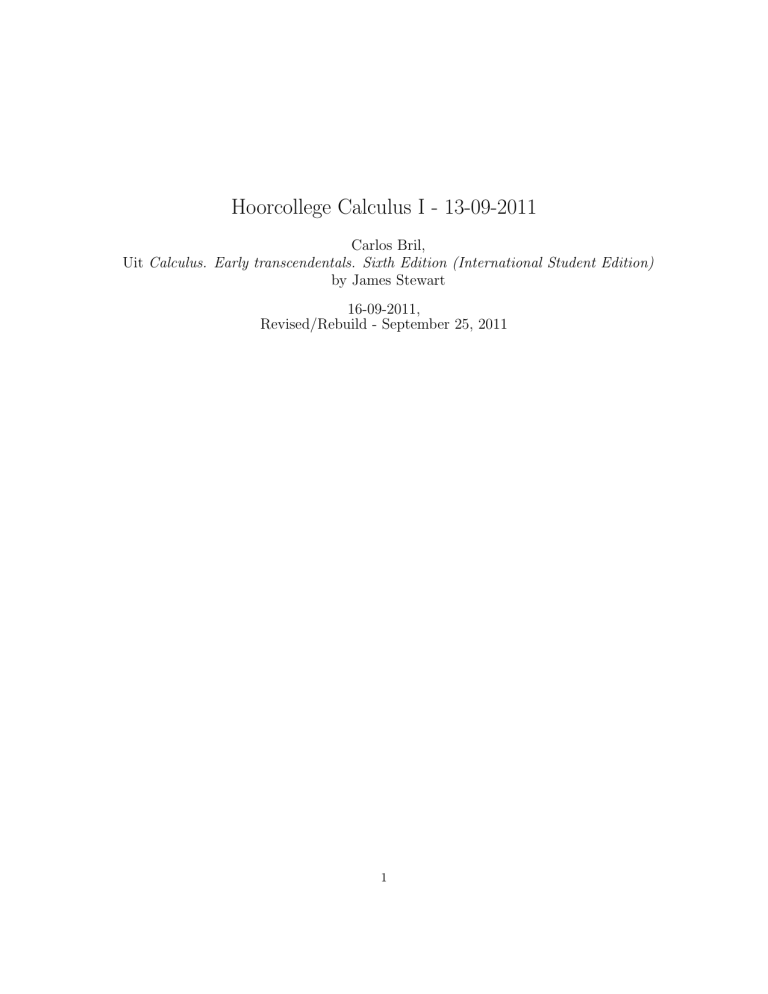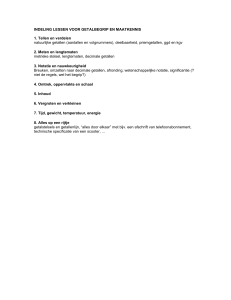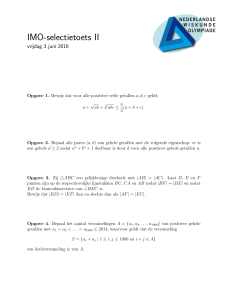
Hoorcollege Calculus I - 13-09-2011
Carlos Bril,
Uit Calculus. Early transcendentals. Sixth Edition (International Student Edition)
by James Stewart
16-09-2011,
Revised/Rebuild - September 25, 2011
1
1
1
VERVOLG COMPLEXE GETALLEN
Vervolg Complexe Getallen
1.1
Example:
2
z +√z + 1 = 0 geeft:
√
−1± 1−4
= − 12 ± 12 i 3.
2
Deze heeft de vorm z = x + iy, die we gewend zijn bij Complexe Getallen.
1.2
e-machten en/als Complexe Getallen
Complexe getallen kunnen ook in e-machten gebruikt worden: ez = ex ∗ eiy . Let hierbij op dat het
Reële deel ex (oftewel ex ∈ Re) is, en het Imaginaire deel eiy (oftewel eiy ∈ Im). Deze laatste gaan
we dan weer herschrijven:
eiy ≡ cos(y) + isin(y)1 . Dat dit zo is kunnen we aan een paar dingen afleiden:
In z = r(cos(θ) + isin(θ)) is rcos(θ) het Reële deel en risin(θ) het Imaginaire deel. r zelf is een
reel getal, en hoort dus niet bij het ”Imaginaire deel”. Verder, laten we kijken naar een belangrijke
eigenschap van een e-macht:
Als je een e-macht differentieert krijg je die zelfde e-macht maal een constante (meestal 1). Als de
definitie geldt moet dit dus ook waar zijn voor eiy = cos(y) + isin(y):
[eiy ]0 = [cos(y) + isin(y)]0 ⇔
ieiy = −sin(y) + cos(y) ⇔
ieiy = i(cos(y) + isin(y)) ⇔
eiy = cos(y) + isin(y). Dit klopt!
Als laatste nu de definitieve vorm voor Complexe Getallen:
z = r ∗ eiθ met r, θ die cordinaten geven in het complexe vlak.
1.3
Euler’s Identity
Als een extra weetje, stel dat we voor y = π invullen, hieruit volgt:
eiπ
=
cos(π) + i sin(π) ⇔
e
iπ
=
−1 + i ∗ 0 ⇔
e
iπ
=
0
+1
Deze formule eiπ + 1 = 0 wordt ook wel de Euler Identiteit genoemd en wordt geroemd om het
feit dat deze formule 5 basisgetallen uit de wiskunde bij elkaar zet: e, π, i, 1 en 0.
Volgens wikipedia:
1 Deze formule wordt ook wel de Euler formule genoemd naar haar bedenker, zie http://en.wikipedia.org/wiki/
Euler’s_formula
2
1.4
Another Example
1
VERVOLG COMPLEXE GETALLEN
Euler’s identity is considered by many to be remarkable for its mathematical beauty.
These three basic arithmetic operations occur exactly once each: addition, multiplication,
and exponentiation. The identity also links five fundamental mathematical constants:
• The number 0, the additive identity.
• The number 1, the multiplicative identity.
• The number π, which is ubiquitous in trigonometry, the geometry of Euclidean
space, and analytical mathematics (π = 3.14159265...)
• The number e, the base of natural logarithms, which occurs widely in mathematical
and scientific analysis (e = 2.718281828...). Both π and e are transcendental
numbers.
• The number i, the imaginary unit of the complex numbers, a field of numbers that
contains the roots of all polynomials (that are not constants), and whose study leads
to deeper insights into many areas of algebra and calculus, such as integration in
calculus.
1.4
Another Example
ez
=
−1 ⇔
ex eiy
=
−1, dus r = ex en θ = y ⇔
1 ∗ ei(π+k∗2π)
=
−1.[2 ]
ex = 1
∧
eiy = ei(π+k∗2π) ⇒
x=0
∧
y = π + k ∗ 2π
Dus {x, y} : {0, π + k ∗ 2π}. Hieraan kunnen we al zien dat
alle oplossingen van deze gelijkheid op de Im-as liggen,
immers, x = 0. Zie figuur 1.
Figure 1: Oplossingen
voor ez = −1
3
1.5
1.5
Yet Another Example
1
VERVOLG COMPLEXE GETALLEN
Yet Another Example
z2
=
1+i
z
=
reiθ ⇔
z2
=
r2 e2iθ 3 ⇔
i in poolcordinaten kun je zien als:
r
=
θ
=
z2
2 (
r e 2iθ)
√
r2 = 2
√
4
r= 2
=
=
∧
∧
√
(12 ) + (12 ) = 2,
1
π
arctan = + 2kπ,1 + i
1
4
1+i⇔
√ i( π +2kπ
2e 4
⇒
p
π
e2iθ = ei( 4 +2kπ
π
θ = + kπ
8
4
=
√
π
2ei( 4 +2kπ












